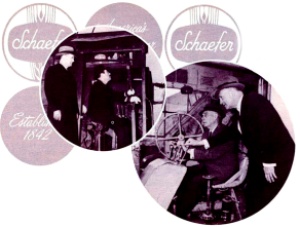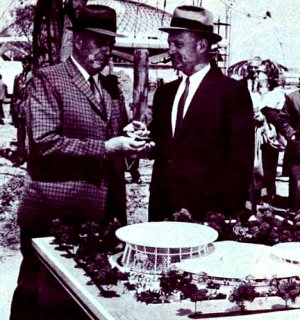Schaefer Center at the New
York World's Fair will consist of two domed buildings, housing
a restaurant and an exhibition hall, and an old-fashioned beer
garden. Architects are Eggers and Higgins and Walter Dorwin Teague
Associates are the designers.
 |
SOURCE: Groundbreaking
Brochure, The Schaefer Center
|
Excerpts from transcription of
remarks made by Schaefer and World's Fair officials at the groundbreaking
ceremonies for Schaefer Center, New York World's Fair, Thursday,
April 25, 1963.
WILLIAM BERNS [Vice President,
Communications and Public Relations]: Members of the press, this
is a happy occasion for us. Almost from the very outset we knew
there was going to be fun at the Fair because Schaefer announced
its participation early. Just the mention of the name is enough
to indicate fun, because it is a familiar name. With the name
goes a great deal of tradition: the 300th anniversary of the
City of New York and the 122nd anniversary of the Schaefer Brewing
Company. All of us at the Press Building know that there's going
to be a great deal of activity connected with the fun in this
building. We are delighted that Eggers and Higgins, an enthusiastic
group, are architects and designers of the building. Incidentally,
Eggers and Higgins also were architects for this Press Building.
Designers for the interior of the Schaefer Center are Walter
Dorwin Teague Associates, and George A. Fuller Company is in
charge of construction.
I think most of us are familiar
with the head of the Schaefer Company. He is known, among other
things, for his great interest in sports activities, and consequently
we feel that his interest will also be evident when the sporting
events are held in connection with the U.S. Olympic Trials in
New York City next year. We are delighted to present the chairman
and president of The F. & M. Schaefer Brewing Company, Mr.
Rudie Schaefer.
|
THEN AND NOW - R.J. Schaefer,
president of The F. & M. Schaefer Brewing Co. watches as Robert
Moses (seated), president of the 1964-1965 New York World's Fair,
breaks ground for the Schaefer Center (photo right). Twenty-four
years ago (left), R. J. Schaefer (standing), and 1939-1940 World's
Fair President Grover Whalen, performed the same ceremony.
 |
|
MR. RUDIE SCHAEFER: Thank you.
Mr. Moses, distinguished guests and friends. I am pleased to
welcome all of you who have taken time to join us in the brief
groundbreaking ceremony for the Schaefer Center, II. I say the
second, because I can recall quite vividly a moment very similar
to this in 1938, when I had the pleasure of breaking round for
the first Center, with the help of the late Grover Whalen, president
of the World's Fair at that time.
While faces and themes change
with the passing of twenty-four years, the enthusiasm and expectations
that accompany such a time and occasion are very much the same.
As I look around today, I see the same panorama of activity,
hear the same sounds of construction, and sense the same excitement
of things to come. The equipment is modern and a little different,
but it is still manned and operated by the same lauded and wonderful
men who have always taken such great pride in their accomplishments.
|
|
I said at our site twenty-four
years ago that I was thrilled by the anticipation of what lay
ahead, and extremely proud of our participation. Today, my anticipation
and my pride are even more abundant, more so because I know now
what lies ahead: the magnificent structures that will soon blossom
up all around us, the thrill of opening day, the millions of
visitors from all over the world parading through the streets
and exhibits, the spectacular displays and the education, the
entertainment, the excellent food and, of course, the good beer.
Standing here, I can also recall
the many predictions that so many of us made concerning the great
prospects for the 1939-1940 World's Fair. As optimistic as I
was at that time, I don't think anyone could ever have evaluated
the success of that Fair beforehand, a success that was not necessarily
measured by the number of people who passed through the gates,
or even by the number of glasses of beer that were consumed.
A success that was measured intangibly -- measured by the efforts
of the masses of people who presented exciting ideas, and measured
by the considerable amount of good will that was created.
Observing and hearing about the
wonderful project now under way, I sincerely believe that the
World's Fair of 1964-1965 will present to its millions of visitors
some of the most memorable moments of their lives. We at Schaefer
hope, intend and plan to be a part of this memory, just as we
were back in 1939.
Even today, old friends of mine
still recall our big 122-foot bar, and our Court of Fame, where
many of the well-known personalities of the stage left their
imprints in cement. For 1964, we plan to blend some of this atmosphere
of the past with new concepts in structure and design. We will
use plastic and Fiberglas combined with steel, wood, aluminum
and glass. The unusual feature of floating roofs and the modern
techniques of lighting will be among the more notable new concepts.
These will be combined with a Restaurant of Tomorrow, featuring
the finest in food and drink, an old-fashioned outdoor beer garden,
and displays which will trace the 122-year-old history and growth
in this country of America's oldest lager beer.
I am quite naturally excited
about our plans, and consequently a little eager to get things
rolling. One final thought though, about the role Schaefer will
play in this Fair: we feel that we have a significant contribution
to make to the theme of Peace through Understanding, and we intend
to do so by providing the Fair guests with the real spark of
friendship -- a glass of wonderful beer. I thank you, and I join
you in all of the basic hopes and prayers for the future of mankind
in which this Fair can play such a very important part. Thank
you.
|
|
ROBERT MOSES: Mr. Berns, Mr.
Schaefer and friends. I was delighted with the picture that Rudie
showed me of Grover Whalen at the Schaefer grounbreaking for
the 1939 Fair.
When we were starting work here
at the Fair, I was talking to one of our friends about the theme
-- the symbol, and we got down to what it really is that unites
the world -- the cement, the thing that holds the world together,
the thing that brings people into brotherhood and friendly relations.
We concluded that probably it was beer; that was the one thing
that brought all people together. I really mean that. I think
there's a lot in it and I hope the frothing rivers of beer will
flow as the result of this exhibit.
Real talent, enthusiasm, skill
and ingenuity have gone into this design. I like the idea of
fun; I like the idea of the Beer Garden; I like the idea of entertainment.
And I think these will carry a better message than if you just
had a bottling plant and nothing else.
|
Robert Moses, Fair president,
presents the World's Fair medal to R. J. Schaefer, president of
the F. & M. Schaefer Brewing Co. Beside them is a model of
the Schaefer Center.
 |
|
|
We are delighted to have this
company here, and to have Rudie back again.
The difference in cost between
a show and exhibit for the 1939 Fair and one for this Fair is
not the only thing that you have to think about. The fact of
the matter is, these shows that we are getting here -- these
pavilions and exhibits -- are on a totally different scale. They
represent much more ingenuity than those of the 1939 Fair.
The difference between the General
Motors Futurama in 1939 and the Futurama of General Motors today
is not measured by the difference between eight million dollars
and the forty-plus million dollars which they've gone into. It's
on a much more impressive basis, and it's designed for many more
people to see.
Well again, thank you, and Rudie,
we'll be here to take the froth off the first glass of beer.
|
|